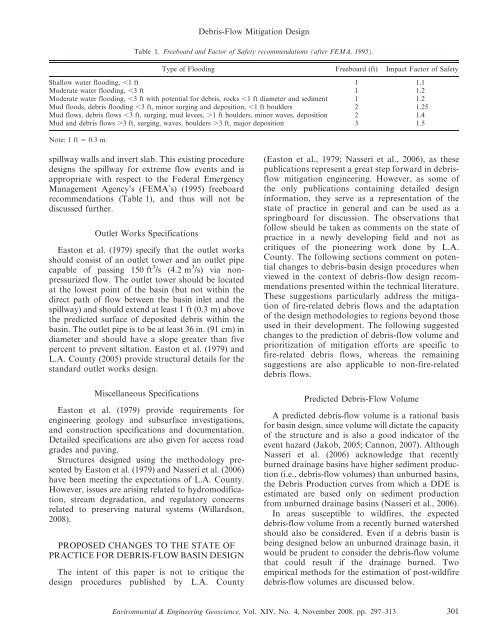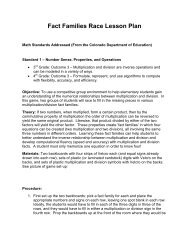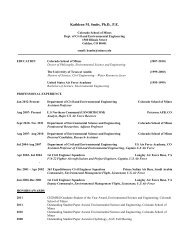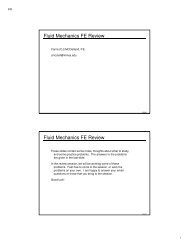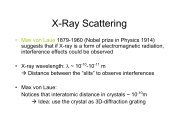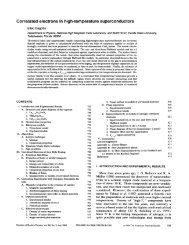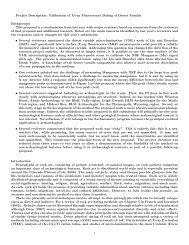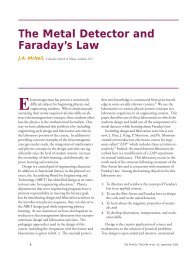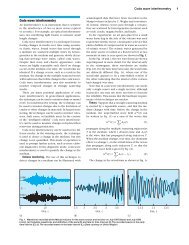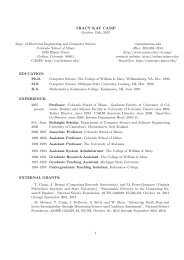Debris Basin and Deflection Berm Design for Fire-Related Debris ...
Debris Basin and Deflection Berm Design for Fire-Related Debris ...
Debris Basin and Deflection Berm Design for Fire-Related Debris ...
You also want an ePaper? Increase the reach of your titles
YUMPU automatically turns print PDFs into web optimized ePapers that Google loves.
<strong>Debris</strong>-Flow Mitigation <strong>Design</strong><br />
Table 1. Freeboard <strong>and</strong> Factor of Safety recommendations (after FEMA, 1995).<br />
Type of Flooding Freeboard (ft) Impact Factor of Safety<br />
Shallow water flooding, ,1 ft 1 1.1<br />
Moderate water flooding, ,3 ft 1 1.2<br />
Moderate water flooding, ,3 ft with potential <strong>for</strong> debris, rocks ,1 ft diameter <strong>and</strong> sediment 1 1.2<br />
Mud floods, debris flooding ,3 ft, minor surging <strong>and</strong> deposition, ,1 ft boulders 2 1.25<br />
Mud flows, debris flows ,3 ft, surging, mud levees, .1 ft boulders, minor waves, deposition 2 1.4<br />
Mud <strong>and</strong> debris flows .3 ft, surging, waves, boulders .3 ft, major deposition 3 1.5<br />
Note: 1 ft 5 0.3 m.<br />
spillway walls <strong>and</strong> invert slab. This existing procedure<br />
designs the spillway <strong>for</strong> extreme flow events <strong>and</strong> is<br />
appropriate with respect to the Federal Emergency<br />
Management Agency’s (FEMA’s) (1995) freeboard<br />
recommendations (Table 1), <strong>and</strong> thus will not be<br />
discussed further.<br />
Outlet Works Specifications<br />
Easton et al. (1979) specify that the outlet works<br />
should consist of an outlet tower <strong>and</strong> an outlet pipe<br />
capable of passing 150 ft 3 /s (4.2 m 3 /s) via nonpressurized<br />
flow. The outlet tower should be located<br />
at the lowest point of the basin (but not within the<br />
direct path of flow between the basin inlet <strong>and</strong> the<br />
spillway) <strong>and</strong> should extend at least 1 ft (0.3 m) above<br />
the predicted surface of deposited debris within the<br />
basin. The outlet pipe is to be at least 36 in. (91 cm) in<br />
diameter <strong>and</strong> should have a slope greater than five<br />
percent to prevent siltation. Easton et al. (1979) <strong>and</strong><br />
L.A. County (2005) provide structural details <strong>for</strong> the<br />
st<strong>and</strong>ard outlet works design.<br />
Miscellaneous Specifications<br />
Easton et al. (1979) provide requirements <strong>for</strong><br />
engineering geology <strong>and</strong> subsurface investigations,<br />
<strong>and</strong> construction specifications <strong>and</strong> documentation.<br />
Detailed specifications are also given <strong>for</strong> access road<br />
grades <strong>and</strong> paving.<br />
Structures designed using the methodology presented<br />
by Easton et al. (1979) <strong>and</strong> Nasseri et al. (2006)<br />
have been meeting the expectations of L.A. County.<br />
However, issues are arising related to hydromodification,<br />
stream degradation, <strong>and</strong> regulatory concerns<br />
related to preserving natural systems (Willardson,<br />
2008).<br />
PROPOSED CHANGES TO THE STATE OF<br />
PRACTICE FOR DEBRIS-FLOW BASIN DESIGN<br />
The intent of this paper is not to critique the<br />
design procedures published by L.A. County<br />
(Easton et al., 1979; Nasseri et al., 2006), as these<br />
publications represent a great step <strong>for</strong>ward in debrisflow<br />
mitigation engineering. However, as some of<br />
the only publications containing detailed design<br />
in<strong>for</strong>mation, they serve as a representation of the<br />
state of practice in general <strong>and</strong> can be used as a<br />
springboard <strong>for</strong> discussion. The observations that<br />
follow should be taken as comments on the state of<br />
practice in a newly developing field <strong>and</strong> not as<br />
critiques of the pioneering work done by L.A.<br />
County. The following sections comment on potential<br />
changes to debris-basin design procedures when<br />
viewed in the context of debris-flow design recommendations<br />
presented within the technical literature.<br />
These suggestions particularly address the mitigation<br />
of fire-related debris flows <strong>and</strong> the adaptation<br />
of the design methodologies to regions beyond those<br />
used in their development. The following suggested<br />
changes to the prediction of debris-flow volume <strong>and</strong><br />
prioritization of mitigation ef<strong>for</strong>ts are specific to<br />
fire-related debris flows, whereas the remaining<br />
suggestions are also applicable to non-fire-related<br />
debris flows.<br />
Predicted <strong>Debris</strong>-Flow Volume<br />
A predicted debris-flow volume is a rational basis<br />
<strong>for</strong> basin design, since volume will dictate the capacity<br />
of the structure <strong>and</strong> is also a good indicator of the<br />
event hazard (Jakob, 2005; Cannon, 2007). Although<br />
Nasseri et al. (2006) acknowledge that recently<br />
burned drainage basins have higher sediment production<br />
(i.e., debris-flow volumes) than unburned basins,<br />
the <strong>Debris</strong> Production curves from which a DDE is<br />
estimated are based only on sediment production<br />
from unburned drainage basins (Nasseri et al., 2006).<br />
In areas susceptible to wildfires, the expected<br />
debris-flow volume from a recently burned watershed<br />
should also be considered. Even if a debris basin is<br />
being designed below an unburned drainage basin, it<br />
would be prudent to consider the debris-flow volume<br />
that could result if the drainage burned. Two<br />
empirical methods <strong>for</strong> the estimation of post-wildfire<br />
debris-flow volumes are discussed below.<br />
Environmental & Engineering Geoscience, Vol. XIV, No. 4, November 2008, pp. 297–313 301


